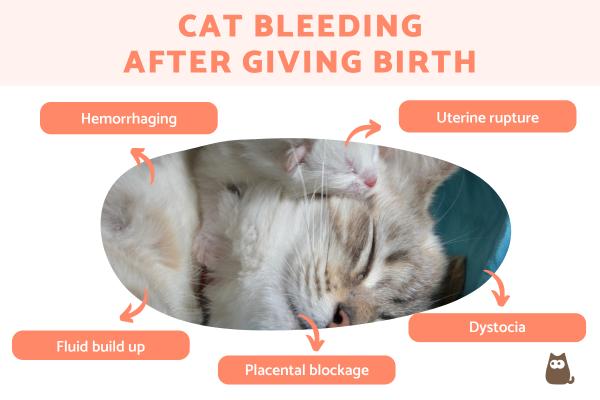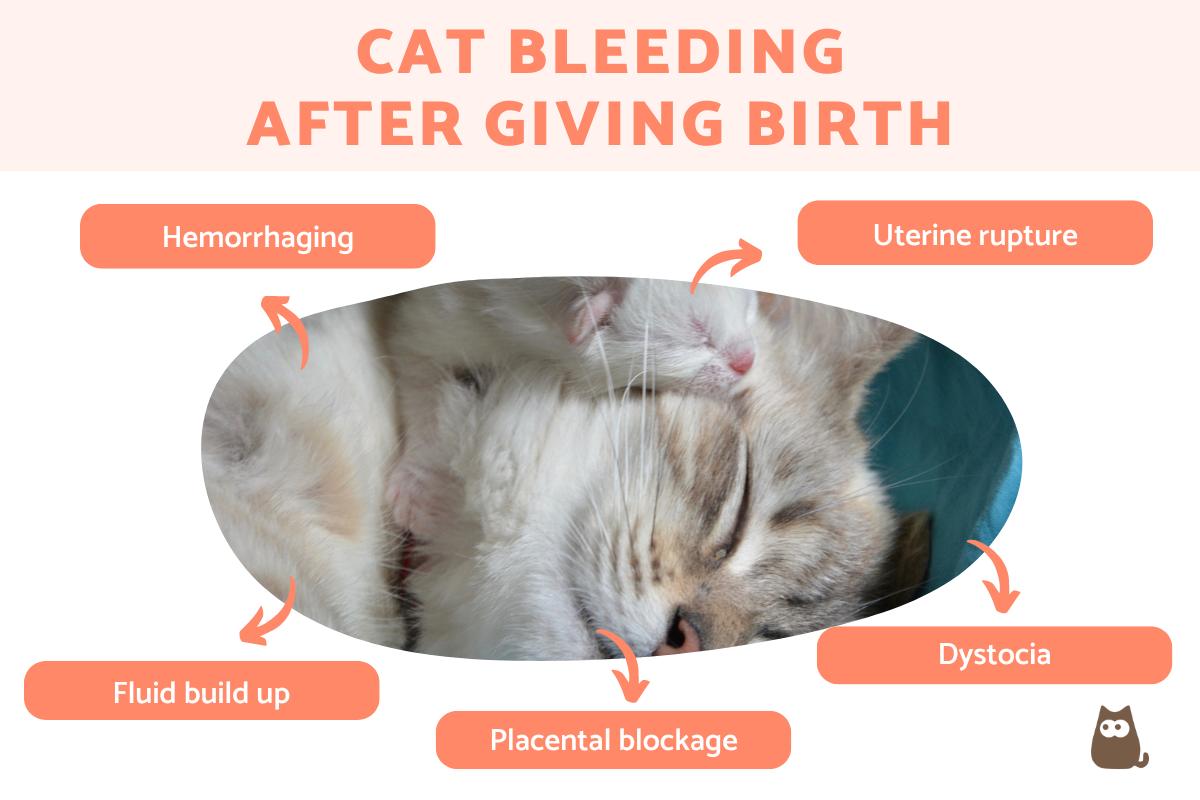My Cat is Bleeding After Giving Birth



See files for Cats
We can expect some blood to be present when a cat delivers her kittens during labor, a process also known as queening in cats. Born in amniotic sacs, the kittens will also be birthed with placental fluid, some of which may contain blood. Often this blood is the result of ruptured blood vessels, something which is common when the mother cat is pushing for delivery of her kittens. The amount of blood which accompanies the birth is often not as much as some guardians may expect, although the amount if variable according to different factors. With this in mind, it is not common to continue bleeding long after the birth, nor will a normal birth produce a lot of blood.
At AnimalWised, we learn more about possible birthing complications without article on why my cat is bleeding after giving birth. We look at how much blood is normal during and after queening, as well how long cats bleed after giving birth.
How much blood is normal during a cat birth?
A cat's pregnancy will last approximately 60 days. After this time, the cat will deliver her kittens. Generally, this will take place during the night. The cat looks for a quiet place to feel safe, warm and comfortable. They will most commonly give birth without any help, preferring the security of seclusion. While you may be able to observe at a distance, you don't want to interact with them if you can help it. It is normal for the cat to have stopped eating before delivery.
When the kitten is born, it is birthed inside a membranous sac known as the amnion. The mother tears this sac open with her teeth and severs the umbilical cord. They will then lick the kittens clean to remove any secretions. Each kitten should only have a few minutes between birth and the process of tearing the sac and cleaning is repeated until all kittens are born.
It is normal to see a little blood in the secretions during labor. This doesn't mean the mother cat is actively bleeding. The blood is usually the result of ruptured blood vessels. This can be due to strain when pushing, but also when the amnion separates from the uterine wall. The cervix will also need to dilate to allow queening, during which the tissue may tear a little and present some bleeding.
While some small amount of bleeding is common, there are different complications which may occur during a cat's delivery. This may have to do with both physical problems as well as mental stress if the cat is not in a good position to deliver the kittens. If the cat is unwell or unable to do so, we will have to care for her kittens to ensure their health.

How to know if a cat has finished giving birth
If the cat has had an ultrasound or radiography, it is possible the veterinarian will have told us how many kittens she can expect. By counting them, we will be able to tell when the delivery has finished. Many guardians of a pregnant cat will want to know how many kittens there are in a litter. The average amount of kittens per birth is 3 to 5. However, it is possible for a cat to have larger litters. Although much less common, it is also possible to have only one kitten. In these cases we have to be particularly careful in case there is another baby trapped inside.
In cases where we do not know how many kittens to expect, we can look for the normal behavior of a mother cat after giving birth. They will likely stay calm and relaxed, letting their kittens start to nurse after they have cleaned them appropriately. Some of this might involve a little blood, especially if it is a large litter.
However, there are some signs a cat may not have given birth to all their kittens. If you see a cat is making movements that they are trying to give birth without a kitten being born, it could be a sign something is wrong. The kitten may be stuck in the canal or there may be some tear of tissue. In both cases, bleeding may occur.
If you notice that the cat passes either a green or bloody discharge through the vulva, then we need to go to the veterinarian immediately. Such discharge is not to be confused with the placenta. This will be a mass of tissue which looks a little like an organ. The mother cat should eat the placenta to derive more nutrients. While there may be some blood on the placenta, it should not be an abnormal amount.
How long do cats bleed after giving birth?
As explained above, there may be some minimal bleeding during queening. Blood from the uterine wall or mixed in with the placenta may take a little time to be discharged with the birthing fluids. The amount will depend on the individual, but it is not uncommon for some blood to present in discharge weeks after the birth. If so, this amount will be minimal. Another reason might be blood from a torn cervix which will take some time to heal.
It is vitally important we differentiate between this discharge and fresh bleeding. It is not normal for a profuse amount of blood to occur during or after queening. In these cases, there may be a complication, something we explain in the section below. This is compared to a normal birth without complications.
After the mother cat gives birth, she will be dedicated to the care of her kittens. The young will need to feed, be cleaned and keep warm. The latter is particularly important as newborn kittens are unable to regulate their own body temperature. Neither can newborn kittens urinate and defecate on their own. The mother stimulates their genital and anal regions with their tongue to help them pass urine and feces. If for any reason the mother cannot do this, then you will have to help the kitten defecate yourself.
The mother cat will spend practically of their time with the kittens, usually only getting up to us the litter box, eat and drink. As the kittens start to grow, they will develop more independence and the mother will leave them on their own more often. If more than one kitten is born, the siblings will begin the feline socialization process. They will learn how to play and fight, something the mother will monitor.
When a cat is about to give birth, they will look for somewhere safe to do it. It will also need to be clean so there is less risk of contracting an infection. We can provide a suitable place such as a cat bed or even a cardboard box with blankets. The cat may choose their own place, so don't force this on them. You shouldn't disturb the cat otherwise they may feel vulnerable.

Reasons a cat is still bleeding after giving birth
A wild cat will give birth on their own without any interference with humans. In the vast majority of domestic cat queening, events will pass smoothly on their own. Many guardians of a pregnant cat will go to bed and wake up in the morning with a litter of healthy kittens awaiting them. With this in mind, there are potential complications during a birth which might cause some concern. Here are some symptoms you should watch out for:
- More than 24 hours passes without the cat eating, drinking or urinating
- If they show signs of fever or if they have a lowered body temperature
- If the cat still looks to be in labor, but no kittens have emerged for over an hour
- The cat's mucous membranes are not pink
- The cat has vomiting and/or diarrhea
- Secretions passed through the vulva continue long after all kittens have been born
In terms of bleeding after giving birth, there is a normal amount. This will be a little around the vulva and may be passed as each kitten is born. The expulsion of the placenta is likely to be accompanied by a little blood also. The amnions of the kittens and other mucous membranes may be present. However, the blood itself should be normal colored. It may be accompanied by a little watery discharge which may have some green or yellow coloring. However, if you see pus or other viscous green colored material, it may be cause for concern.
Abnormal bleeding may be caused by various factors, but all of them will need to be addressed. The most common causes of bleeding after a cat gives birth are:
- Hemorrhaging (internal bleeding)
- Rupture of the uterus
- Fluid build up
- Blockage of the placenta
- Blockage of an unborn kitten (dystocia)
The reasons for many of the issues which cause excessive bleeding after a cat gives birth are various. The problem is sometimes the mother's inability to make the uterine contractions necessary to birth the kittens. This can be seen when the cat is making motions as if to give birth, but no kittens emerge.
Sometimes the kitten is so large, it makes passing through the birth canal difficult. The kitten may eventually be born, but the force of the pushing causes the tissue to tear and hemorrhaging to occur. The bleeding might stop itself, but it might take some time to pass all of the blood. If the tear doesn't repair, it can cause a lot of pain and lead to a serious compromise of health.
Infections can occur for various reasons, often to do with their general hygiene. Genetic may also play a part. Dystocia is the scientific word for obstructed labor. This might be caused by the mother cat having too narrow a pelvis or by having problems inflammation issues in the uterus.

What to do if my cat is bleeding after giving birth
As we stated above, it is normal for some bleeding to occur after a cat gives birth. However, this bleeding should not be profuse. Commonly the blood will present as spotting, meaning you will only see a few spots of blood. If you see a cat dripping blood after giving birth, then this is not normal and implies there is a serious problem.
Spotting is normal for about 48 hours after a cat gives birth. If it continues to happen after this time, you should take them to the vet to rule out a problem. You will need to also look at other symptoms. If the cat stops eating, has vomiting and/or diarrhea or any other symptoms where you think they may be ill, you need to take them to the vet.
If the cat has an infection, it can be worrying for the kittens. As the kittens are both feeding off their mother and in very close proximity, infection can spread. The vet will be able to treat the infection and also examine the kittens to ensure their well-being is not compromised. If the problem is due to a blockage or hemorrhaging, they will be able to examine the cat and provide a diagnosis. The treatment will vary according to the cause, with antibiotics being common and surgery being required in acute cases.

This article is purely informative. AnimalWised does not have the authority to prescribe any veterinary treatment or create a diagnosis. We invite you to take your pet to the veterinarian if they are suffering from any condition or pain.
If you want to read similar articles to My Cat is Bleeding After Giving Birth, we recommend you visit our Reproductive system diseases category.








